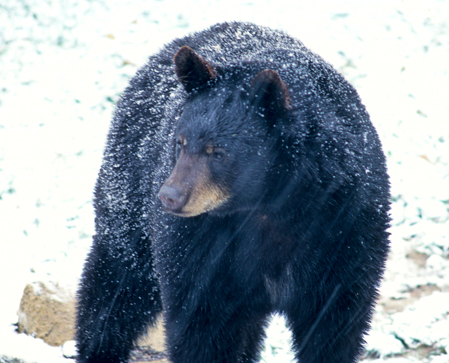BY Lee McClellan
FRANKFORT, Ky. – Kentucky hunters took 20 bears during the 2013 bear season that concluded this past December. This season introduced an expanded bear hunting zone as well as an archery and crossbow season.
Both the firearm and archery/crossbow bear seasons received a 10-bear quota for the 2013 seasons for a total of 20 bears. Hunters can now hunt bears in 16 Kentucky counties, up from four counties in 2012.
“We are very excited that hunters met the 10 bear quota both during the new archery and crossbow season as well as the firearm season,” said Steven Dobey, bear biologist for the Kentucky Department of Fish and Wildlife Resources. “It was gratifying to see our hunters get out there and be productive.”

Hunters harvested eight male and two female bears during the firearms bear season. They took six males and four females during the archery and crossbow bear season. No hunters harvested a bear during the bear quota hunt with dogs that ran for five days in late December after the conclusion of the firearm and archery and crossbow bear seasons.
“We had bears harvested in six counties; three of those were outside the original bear zone,” Dobey explained. Letcher County accounted for seven bears harvested, the most of any county in the 16-county bear zone. Hunters took three bears each in Harlan, Leslie and Perry counties and two bears in both Pike and Wayne counties. All bears were taken on private land.
Kentucky’s bear zone includes Bell, Clay, Floyd, Harlan, Knott, Knox, Laurel, Leslie, Letcher, Martin, McCreary, Perry, Pike, Pulaski, Wayne and Whitley counties. Kentucky’s highest bear population densities are along Pine Mountain, which stretches from Breaks Canyon on the Russell Fork of Big Sandy River in Pike County through Letcher and Harlan counties.
“Outside the Harlan and Letcher corridor, the next highest concentration of bears in Kentucky is in McCreary and Wayne counties,” Dobey said. “They have been there for at least 15 years.”
These bears are distinct from those in the Harlan and Letcher county areas. “They are genetically more similar to bears from the Smokey Mountains than bears from the Pine Mountain region,” Dobey said. “They descend from 14 female bears released in the Tennessee portion of the Big South Fork National River and Recreation Area for a study in the mid-1990s.”
Bear hunting in modern times in Kentucky began in December of 2009. Doug Adkins of Jenkins, Kentucky, set the state record in 2012 with a black bear that weighed 410 pounds field dressed.
Author Lee McClellan is an award-winning associate editor for Kentucky Afield magazine, the official publication of the Kentucky Department of Fish and Wildlife Resources. He is a life-long hunter and angler, with a passion for smallmouth bass fishing.
-30-
The Kentucky Department of Fish and Wildlife Resources manages, regulates, enforces and promotes responsible use of all fish and wildlife species, their habitats, public wildlife areas and waterways for the benefit of those resources and for public enjoyment. Kentucky Fish and Wildlife is an agency of the Tourism, Arts and Heritage Cabinet. For more information on the department, visit our website at fw.ky.gov.


Be the first to comment